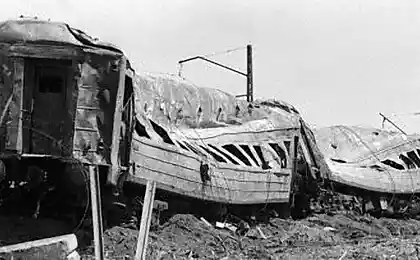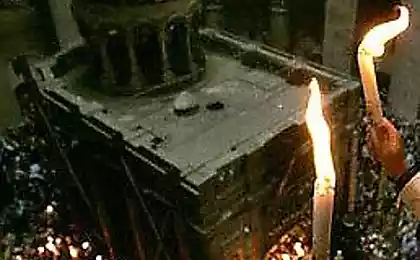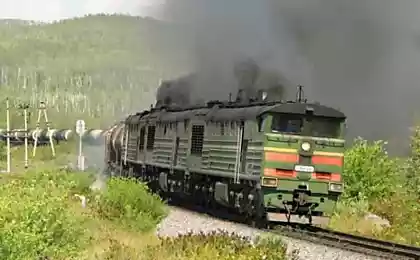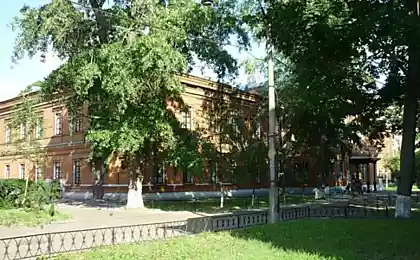931
The story of locomotives 2
In the first part of the story I briefly spoke about the structure and principles of the locomotives. In this article, I will tell about how the locomotives are repaired as is their disassembly, repair, assembly and subsequent adjustment. Unfortunately, during the filming of my digicam finally died, and in some cases (in order to avoid trouble) had photographed almost clandestinely, so fotkal to "Sneakers". But, in principle, the photo is quite picky, everything you need, it smotribelno.Nu and gourmets-aesthetes of photography in advance my deepest apologies.
So there you go. Will foto.Prosba 36, a selection not to break, and then answer questions, if there are.
Repair of locomotives on the degree of complexity (value) depends on their runs. The higher mileage, the larger repairs. The largest repair - with a recess diesel generator of the locomotive followed by disassembly and diesel generator, repair of all components and assemblies, followed by the assembly, tuning and adjustment of diesel-generator set (rheostat tests) .There are more minor repairs when the diesel can not be removed completely of the locomotive and its partial demolition, ie the state of the diesel engine is that it is not necessary to disassemble the whole, and it is possible to disassemble and repair only the parts that need to be repaired. It was here, too, I'll

Before dismantling of the locomotive merge all liquids: water, fuel, oil, poured the sand from the bunkers. Then, the fuel tank is washed and proparivaetsya.Na this photo comes steaming fuel tank tease razekipirovki locomotive.
Then the locomotive is placed in the shop. There is a diesel engine disassembly, it disconnects all the pipelines and disconnected from the diesel ramy.Na this photo roof already dismantled for diesel notch.
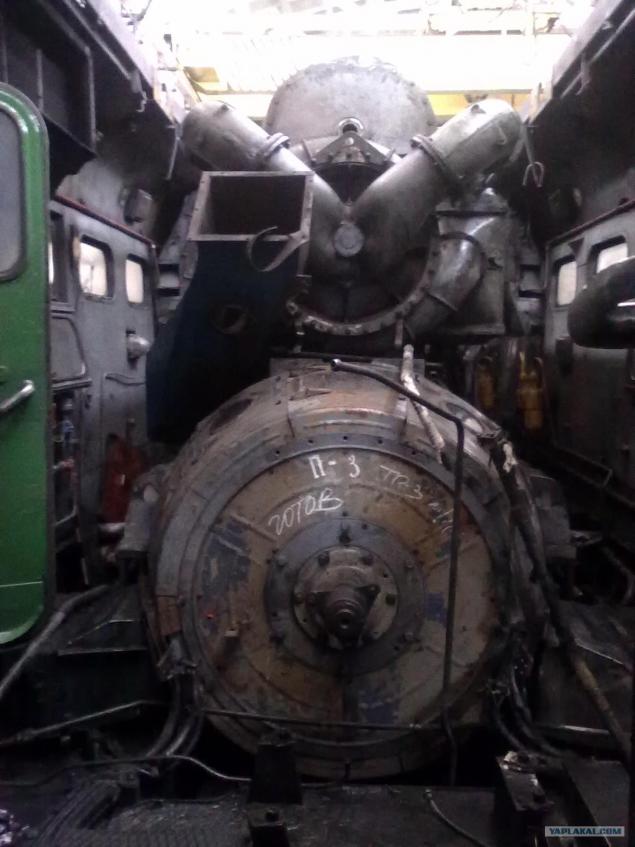
Removing the front gear and air kompressor.Horosho seen Two-machine unit, which will also be dismantled.

This picture shows the comparison of what it was that was after dismantling compare with the top photo. Now you can shoot with a diesel locomotive. Take out his 30-ton crane.

It removes all electrical equipment. Cables were left alone, and they will soon be lifted.
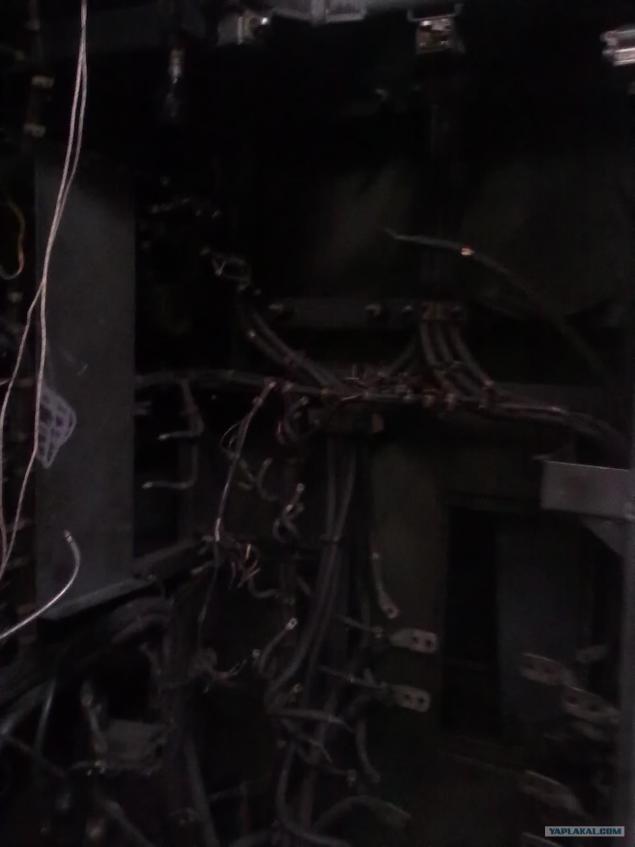
Then the locomotive is placed on the jacks. Detachable cable traction motors are disconnected supporting-return device trolleys, and then pick up on diesel and trolley jacks (each of the two sections, each with three traction motor) rolled out from under the locomotive. Now it is possible to repair the pipelines, and supporting devices of the locomotive.
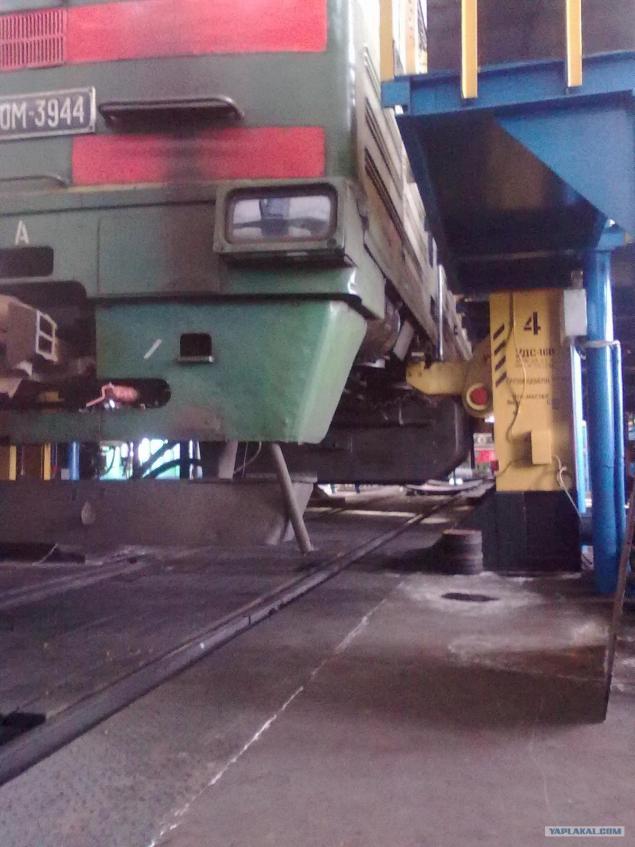
More photos, more closely.
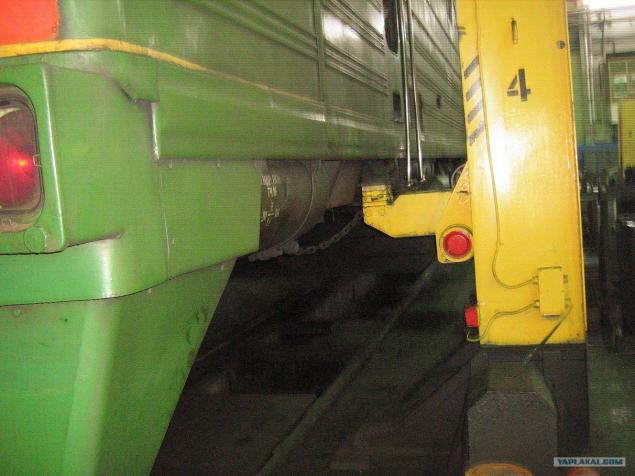
Then traction motors disconnected from the trolley. Then the truck and traction motors, and also completely disassembled and repaired. On ETM photos traction motors renovated and prepared for a test installation back to the truck.
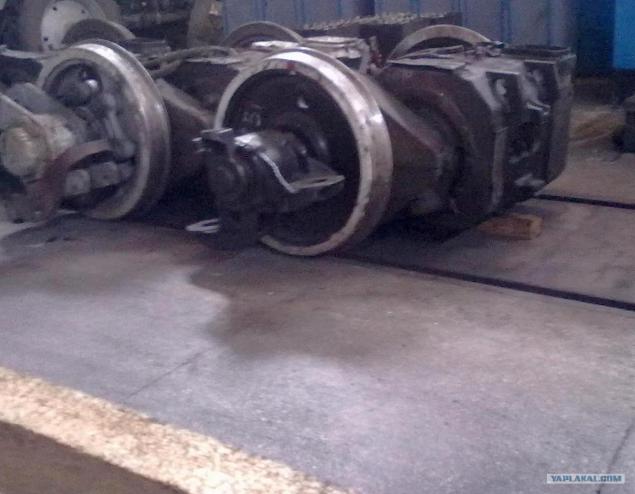
Sometimes you need to repair only one traction motor. In order not to raise the locomotive on jacks and disassemble completely the trolley, invented a device that's called skatoopusknoy mechanism. The locomotive is fitted on skatoopusknik, disconnected cables and fasteners just one tractor, and then it goes down with the platform skatoopusknika and leaves from under the locomotive, which remains standing. Likewise, the traction motor put into place.
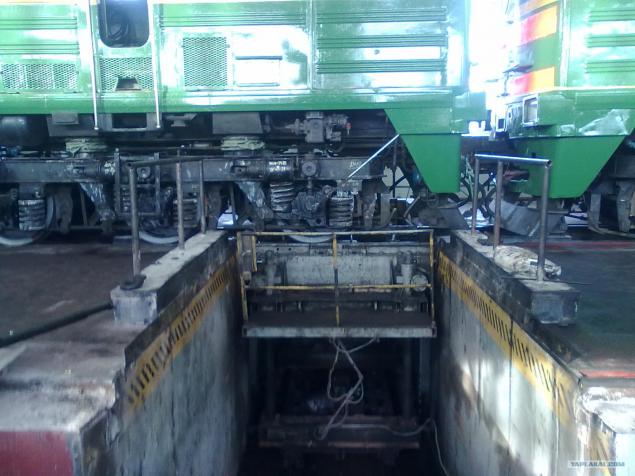
This lathe bandages wheelsets. Typically wheelset disconnected from the traction engine and, where necessary to grind on a special machine. But sometimes it is necessary to grind band without disassembling tractor (well, locomotive ran on some obstacle and get a pothole on the wheel). Then customize locomotive on such a machine, clamped wheel pair in a special caliper slightly lifted and the special shaped cutter grind band, gradually turning the wheel pair.

Let's go back to diesel. He was already half dismantled. Removed traction generator, turbine, and supercharger with charge air coolers.
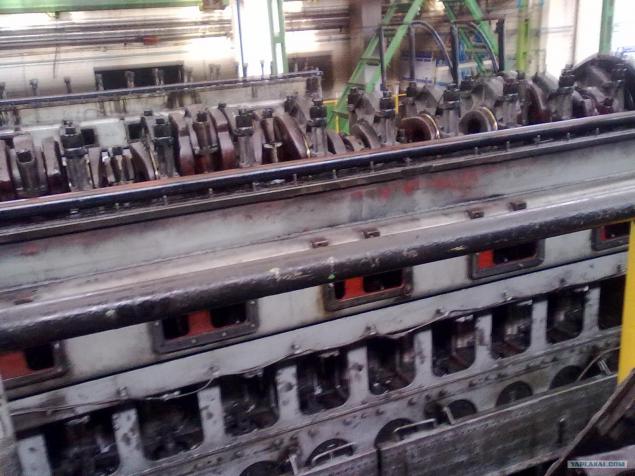
Turbines and driven supercharger for further disassembly and repair on site repair turbochargers. Here they will disassemble, clean, and Balance the Assemble again.
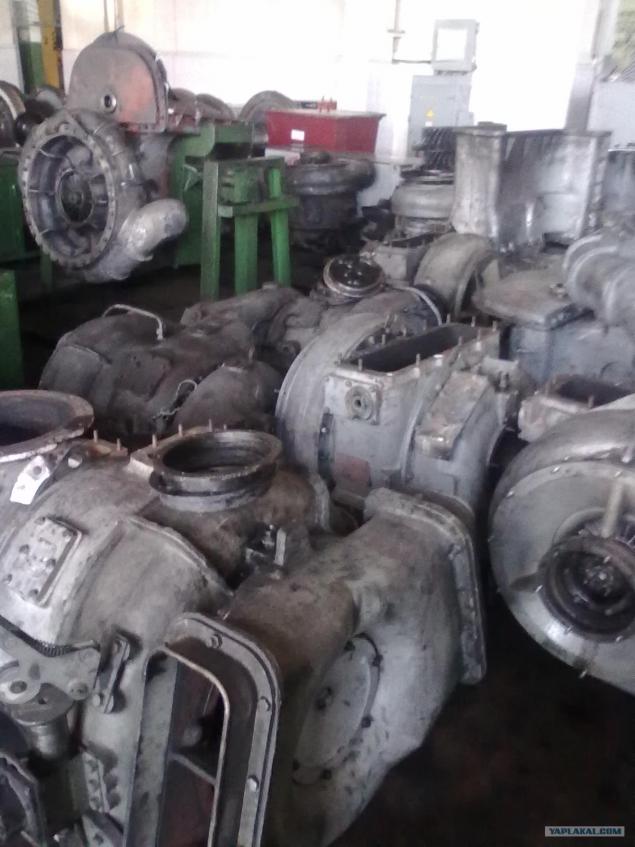
Now remove the upper crankshaft (this diesel are two: the upper and lower). Clearly visible gear drive camshaft high pressure fuel pumps. Camshafts, too, will be removed to check the degree of wear of the cams, because it affects the accuracy of the fuel supply to the cylinders of a diesel engine ...

Crankshafts removed and laid on special supports. Their carefully obotrut, will make measurements of indigenous and crankpins. If everything is OK - return to the place. If not - replace the other.
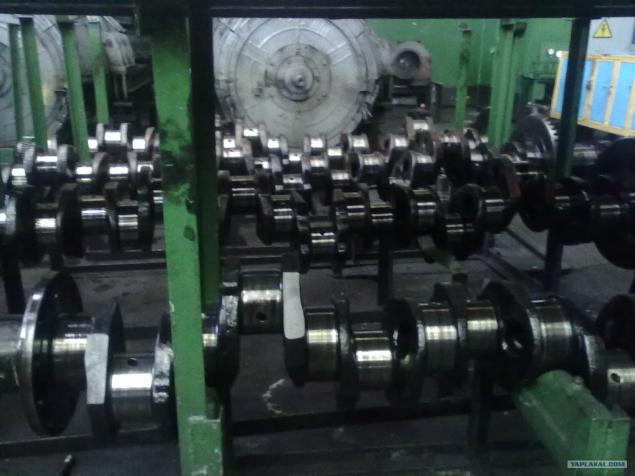
Final demolition diesel. Freezing cylinder liners, the removal of all piping, disconnect the unit from the diesel poddizelnoy frame. Then the unit will send in special washing machines, where hot detergent solution washed clean to metal. Then produce linear measurement unit, not whether it is warped, whether tolerances of all sizes seating cylinder liners and bearings beds. Recently blocks often become defective. What can you do - time prevails. If possible, send units for repair to major locomotive factories. If not - write off.
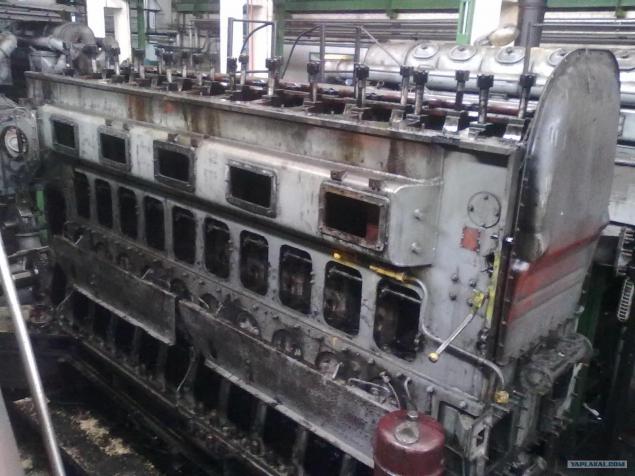
As you know, the assembly after the repair takes place in reverse order.
Now, a short story about partial dismantling of a diesel engine without recesses of his locomotive. It is a smaller kind of repair in which only parts are repaired diesel. For example, consider removing diesel 16CHN26 / 26.Na this photo diesel fully assembled.

And here already removed high pressure fuel pumps and rod drives the intake and exhaust klapanov.Na this photo clearly visible valve springs and rollers rod drives.
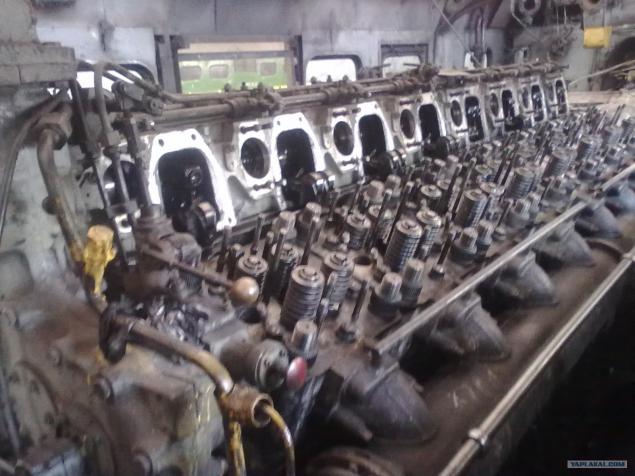
There have removed Included Parts cylinders (Included Parts - a piston with a connecting rod, cylinder sleeve and cylinder cover with valves)

If you look inside, you can see the crankshaft, or rather, one of its crankpins.
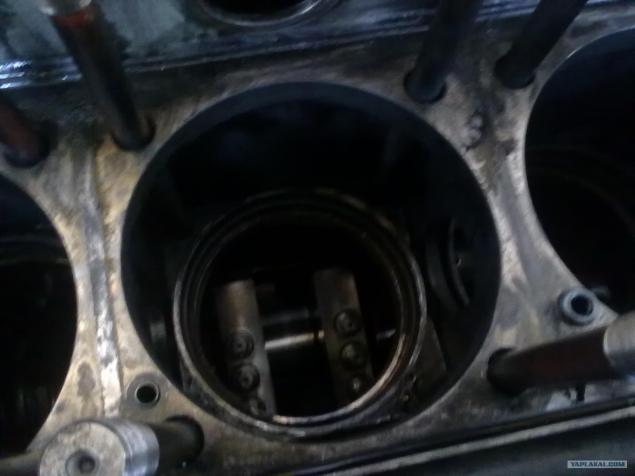
Thus, the locomotive was pulled, and then assembled. Now you need to check the quality of its assembly, to eliminate deficiencies, leaks, identify flaws in the assembly of a diesel engine and an electric circuit, and then configure the DSU. For this locomotive was subjected rheostat tests, for which its electrical power circuit is connected to the water-Load rpm using connecting kabeley.Na this photo water rheostat right.
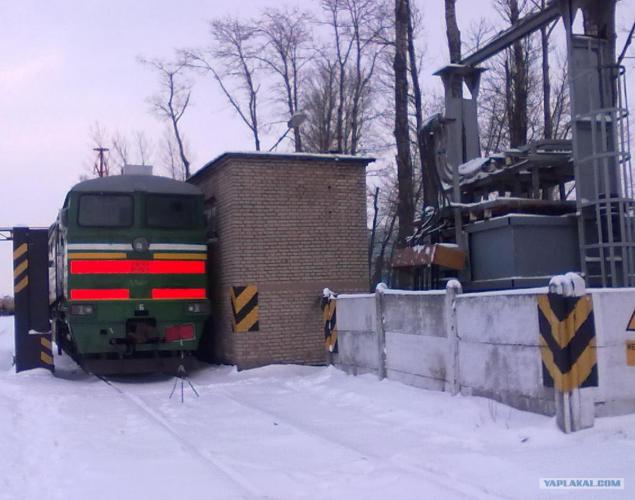
The cables are passed through special processing window in the body of the locomotive. There also connect the control cable to monitor the status of the requested operation modes and circuitry of the locomotive.
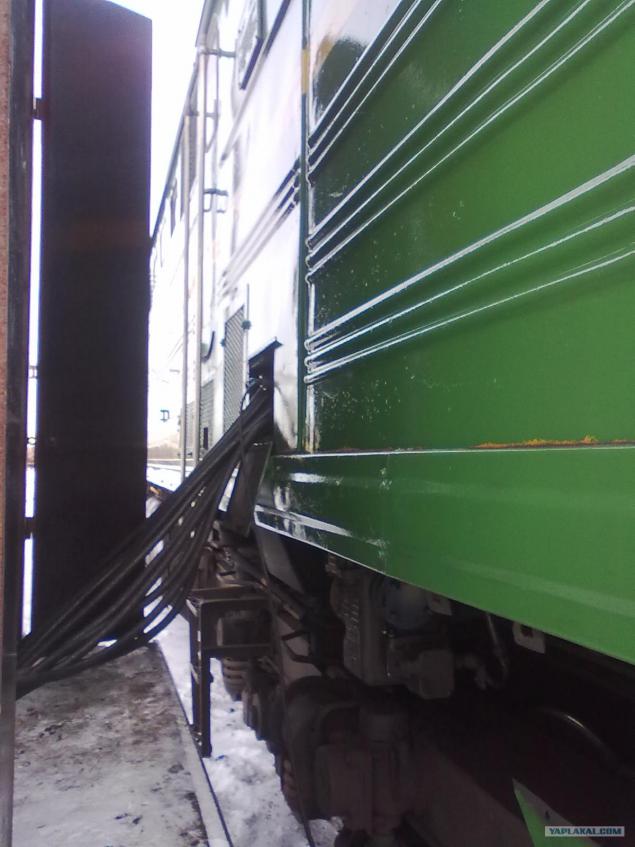
A few words about the rheostat. In fact, it's a giant kettle to 10 tons of water, which is immersed in the metal plates, which are in turn connected to the main generator of the locomotive. But the generator is disconnected from the traction motor, and only works on a rheostat. Thus, we can load the genset locomotive traction motors simulating work in different modes. That is, stooya in place as if we were going. Prietom we are able to customize the genset locomotive under full load, which we need.

That kind of rheostat on top. Visible positive ("plus") and negative ("minus") plate. And plus-plates can be raised and lowered otnsitelno freezing. This is done in order to change the current and voltage of the locomotive traction generator to simulate different modes of driving the locomotive.
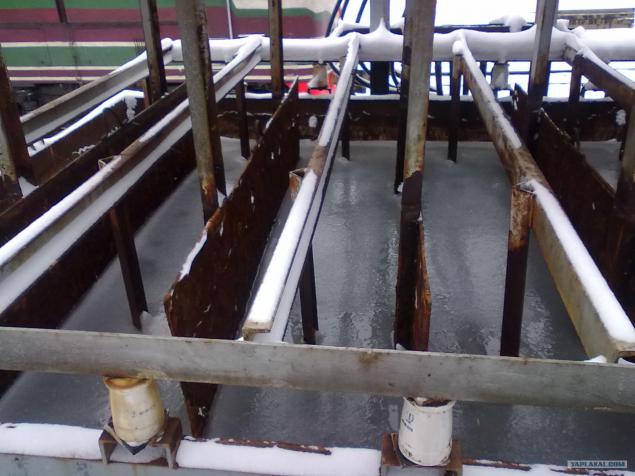
Thus, the locomotive is attached to the rheostat, the primary run revealed no problems with the diesel and the scheme (which is rare, as a rule, the problem is serious, and sometimes satisfied). Check the operation of all systems under low load, simultaneously conducting run-grinding and mobile connections and bearing uzlov.Zaglyadyvaem in various nooks and crannies in search of leaks of water, oil and fuel. Most leaks are found here near the device - a water-oil heat exchanger, which cools the oil locomotive.
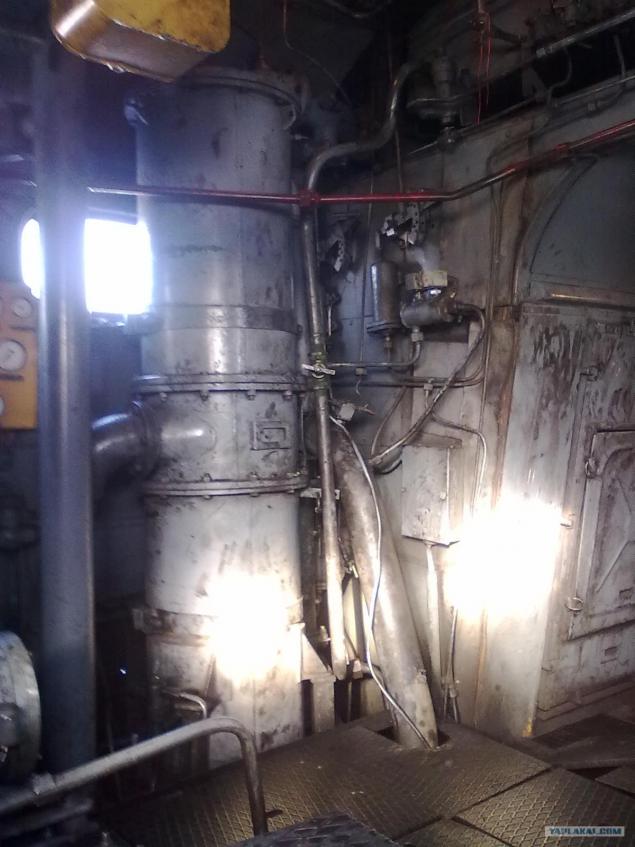
Also check the correct assembly of electrical apparatus locomotive. Because a lot of them, often mistakes happen when their assembly. Sometimes the search for these errors can take a long time.

Now proceed to the rheostat tests. To begin with adjustable RPM diesel, which climbed inside the engine speed regulator. Turnovers adjust the settings here these electromagnets (signals they come with the controller driver), who in turn being included variable speed diesel engine crankshaft. As it happens - I will not describe it enough dolgo.Mogu only say that each position of the controller driver must match exactly a certain number of turns and accurately determine the power of a diesel generator ustanovki.Oboroty controlled using regular tachometer, a piece of which is visible in the photograph, but the required accuracy is achieved by controlling the revolutions with the electronic tachometer that is connected to the diesel locomotives on time rheostat tests.

Turnovers we adjusted now adjustable resistance, which set the level of required power delivered traction alternator.
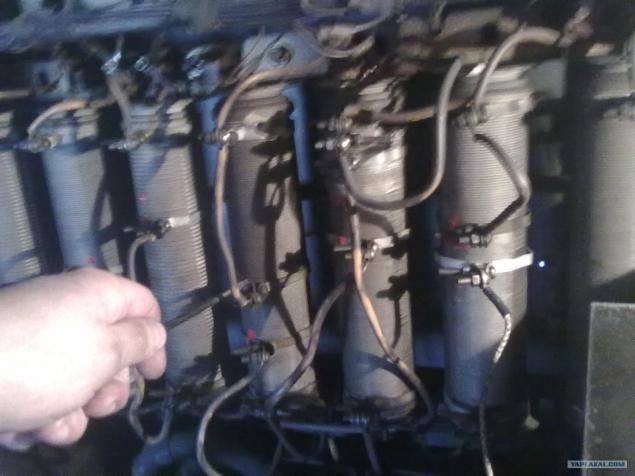
Check the accuracy of the settings before you load generator.
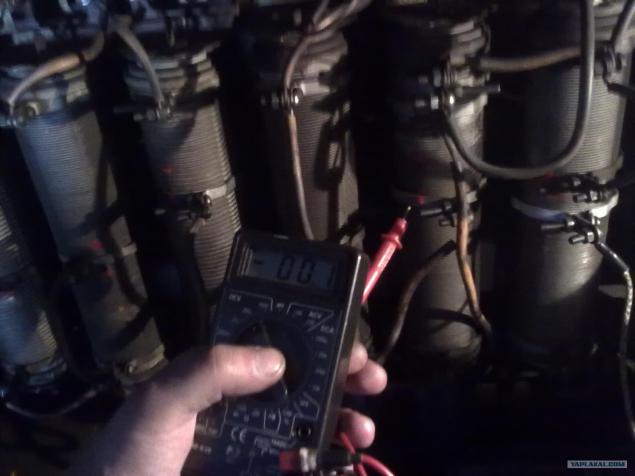
Presses diesel generator and check the matching parameters using control - diagnostic system. In it we see the power, momentum, the currents in the windings of electrical machines and apparatus. If you see a discrepancy in the parameters, then climb into the scheme of the locomotive are looking for the cause and re-adjust, and then check again. And so on to adjust the parameters to the right.

Thus, the circuit is set up. But diesel yet. He has a lot of parameters: the combustion pressure, fuel injection timing angle, compression pressure, exhaust gas temperature, and others. All of these parameters are also necessary to check and adjust according to the set. To do this, we conduct diagnostics of diesel, which hang on a bunch of different sensors. First, vibration sensors for determining the fuel injection timing.
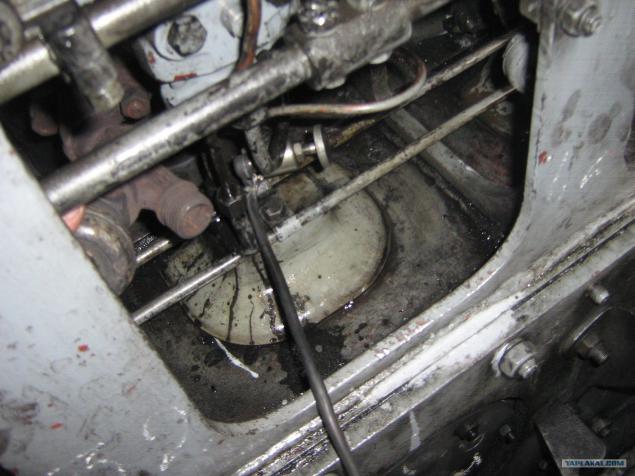
Now you need to determine the combustion pressure in the cylinder of a diesel engine. To do this, we open the valve and purge the indicator, which is directly connected to the combustion chamber of the cylinder. Can you imagine, with some noise, fire, smoke and exhaust gases are pulled out by force from a tap. Now the opposite it is better not to stand, can easily get burned and if run without antinoise headphones, hearing damage you obespecheno.Posle purge valve is closed and it is screwed special pressure sensor constructed so that it can measure the pressure within the combustion chamber to 140 kg / cm at a temperature of 800-900 degrees Celsius, and even higher. Then, the valve opens for easy access to the gas sensor.
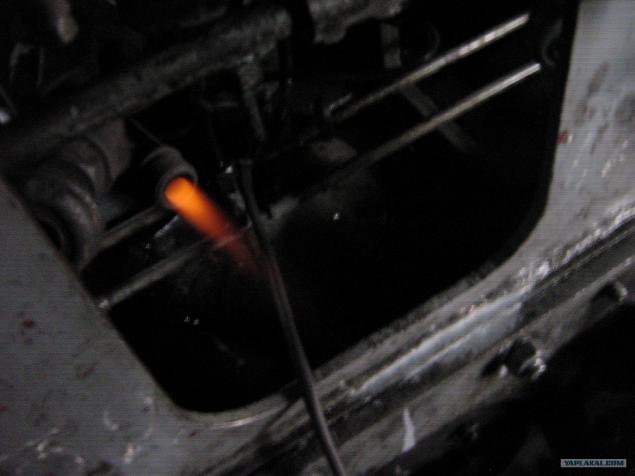
Here is the diesel, hung with sensors diagnostic unit. More control over the temperature of the exhaust gases are inserted into the holes of the thermocouple. In the near term visible local station data collection, processing and transmission of data to a computer control and diagnostic ustanovki.Horosho visible pressure sensors, screwed on the indicator valves. Diesel launched, ground on all cylinders, is collecting data on the state of a diesel generator set.

It looks like one of the diagnostic menu. I'm sorry, it's not a screen shot of just the laptop was in so many scrapes and so experienced that some of the keys simply do not work and one of the unemployed and the Print button is Screen.No because the information from the picture is not so important, I think you'll excuse me.

Here is another menu diagnosis parameters of a single cylinder. Those cylinders that do not fit into the parameters that are subject to regulations: changing faulty pumps, nozzles, changing the angle of the fuel supply timing, cyclic flow fuel pump and so on. Then, measurements are carried out again, and so on until the required parameters.

In recent times, when the diagnosis was not yet, to measure the combustion pressure and the compression pressure in the cylinders used (and still often are), here is a piece - Maximeter. The principle is the same: full power indicator open valve, purged, close, and then wind the peak demand on him again open valve and measures the combustion pressure. You can see that the scale of the pressure gauge has a reserve of up to 160 points. Measurements of parameters Peak - a job for men with strong nerves and health. Imagine a wild noise, the roar of the diesel engine, turbine whine, flames and smoke exhaust from the indicator tap the heat at 80 degrees, and you gently welling - minimize peak demand, fiksiruesh pressure gauge. By the way, the tip of a peak during this work is heated so that it can be easily get a light.
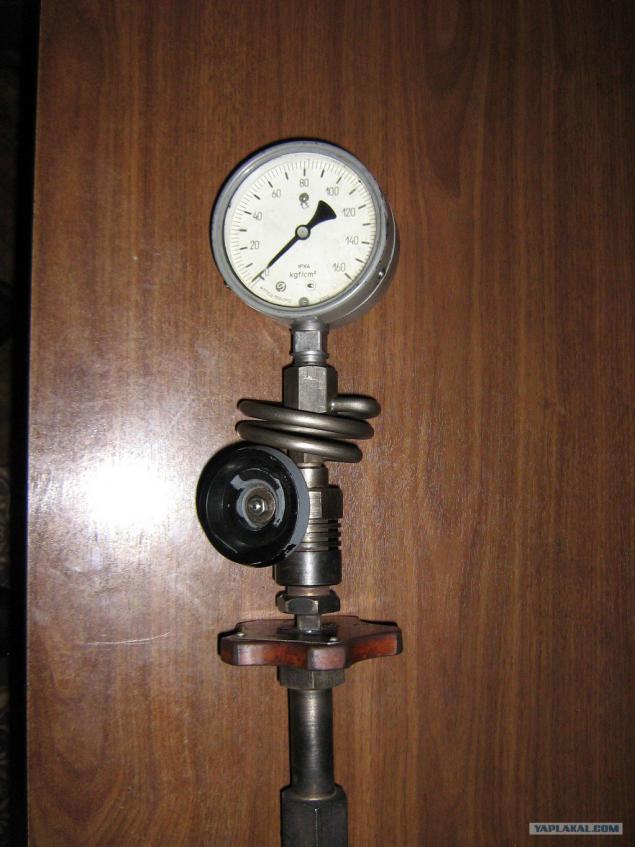
Here is the tank rheostat about the middle of the test. The water has not boiled, but hand it is better not to poke, quite hot.
Then after a rheostat tests locomotive passes break-even where the final check of all systems.
Everything described here, is not even a hundredth part of the reality. A more detailed report would have hundreds of photos with their multi-page description. So do not even try. For me all this.
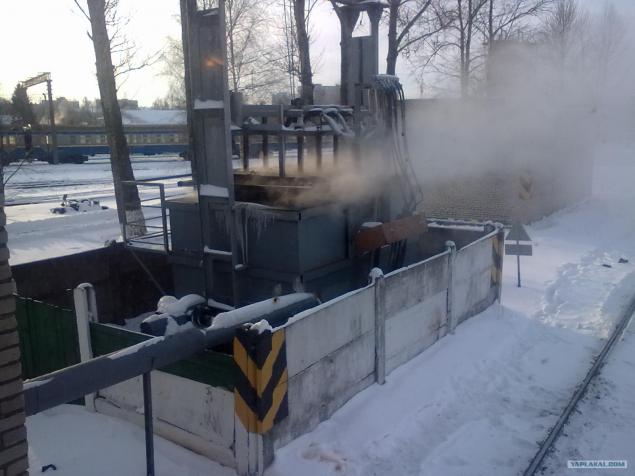
Source:
So there you go. Will foto.Prosba 36, a selection not to break, and then answer questions, if there are.
Repair of locomotives on the degree of complexity (value) depends on their runs. The higher mileage, the larger repairs. The largest repair - with a recess diesel generator of the locomotive followed by disassembly and diesel generator, repair of all components and assemblies, followed by the assembly, tuning and adjustment of diesel-generator set (rheostat tests) .There are more minor repairs when the diesel can not be removed completely of the locomotive and its partial demolition, ie the state of the diesel engine is that it is not necessary to disassemble the whole, and it is possible to disassemble and repair only the parts that need to be repaired. It was here, too, I'll

Before dismantling of the locomotive merge all liquids: water, fuel, oil, poured the sand from the bunkers. Then, the fuel tank is washed and proparivaetsya.Na this photo comes steaming fuel tank tease razekipirovki locomotive.
Then the locomotive is placed in the shop. There is a diesel engine disassembly, it disconnects all the pipelines and disconnected from the diesel ramy.Na this photo roof already dismantled for diesel notch.

Removing the front gear and air kompressor.Horosho seen Two-machine unit, which will also be dismantled.

This picture shows the comparison of what it was that was after dismantling compare with the top photo. Now you can shoot with a diesel locomotive. Take out his 30-ton crane.

It removes all electrical equipment. Cables were left alone, and they will soon be lifted.

Then the locomotive is placed on the jacks. Detachable cable traction motors are disconnected supporting-return device trolleys, and then pick up on diesel and trolley jacks (each of the two sections, each with three traction motor) rolled out from under the locomotive. Now it is possible to repair the pipelines, and supporting devices of the locomotive.

More photos, more closely.

Then traction motors disconnected from the trolley. Then the truck and traction motors, and also completely disassembled and repaired. On ETM photos traction motors renovated and prepared for a test installation back to the truck.

Sometimes you need to repair only one traction motor. In order not to raise the locomotive on jacks and disassemble completely the trolley, invented a device that's called skatoopusknoy mechanism. The locomotive is fitted on skatoopusknik, disconnected cables and fasteners just one tractor, and then it goes down with the platform skatoopusknika and leaves from under the locomotive, which remains standing. Likewise, the traction motor put into place.

This lathe bandages wheelsets. Typically wheelset disconnected from the traction engine and, where necessary to grind on a special machine. But sometimes it is necessary to grind band without disassembling tractor (well, locomotive ran on some obstacle and get a pothole on the wheel). Then customize locomotive on such a machine, clamped wheel pair in a special caliper slightly lifted and the special shaped cutter grind band, gradually turning the wheel pair.

Let's go back to diesel. He was already half dismantled. Removed traction generator, turbine, and supercharger with charge air coolers.

Turbines and driven supercharger for further disassembly and repair on site repair turbochargers. Here they will disassemble, clean, and Balance the Assemble again.

Now remove the upper crankshaft (this diesel are two: the upper and lower). Clearly visible gear drive camshaft high pressure fuel pumps. Camshafts, too, will be removed to check the degree of wear of the cams, because it affects the accuracy of the fuel supply to the cylinders of a diesel engine ...

Crankshafts removed and laid on special supports. Their carefully obotrut, will make measurements of indigenous and crankpins. If everything is OK - return to the place. If not - replace the other.

Final demolition diesel. Freezing cylinder liners, the removal of all piping, disconnect the unit from the diesel poddizelnoy frame. Then the unit will send in special washing machines, where hot detergent solution washed clean to metal. Then produce linear measurement unit, not whether it is warped, whether tolerances of all sizes seating cylinder liners and bearings beds. Recently blocks often become defective. What can you do - time prevails. If possible, send units for repair to major locomotive factories. If not - write off.

As you know, the assembly after the repair takes place in reverse order.
Now, a short story about partial dismantling of a diesel engine without recesses of his locomotive. It is a smaller kind of repair in which only parts are repaired diesel. For example, consider removing diesel 16CHN26 / 26.Na this photo diesel fully assembled.

And here already removed high pressure fuel pumps and rod drives the intake and exhaust klapanov.Na this photo clearly visible valve springs and rollers rod drives.

There have removed Included Parts cylinders (Included Parts - a piston with a connecting rod, cylinder sleeve and cylinder cover with valves)

If you look inside, you can see the crankshaft, or rather, one of its crankpins.

Thus, the locomotive was pulled, and then assembled. Now you need to check the quality of its assembly, to eliminate deficiencies, leaks, identify flaws in the assembly of a diesel engine and an electric circuit, and then configure the DSU. For this locomotive was subjected rheostat tests, for which its electrical power circuit is connected to the water-Load rpm using connecting kabeley.Na this photo water rheostat right.

The cables are passed through special processing window in the body of the locomotive. There also connect the control cable to monitor the status of the requested operation modes and circuitry of the locomotive.

A few words about the rheostat. In fact, it's a giant kettle to 10 tons of water, which is immersed in the metal plates, which are in turn connected to the main generator of the locomotive. But the generator is disconnected from the traction motor, and only works on a rheostat. Thus, we can load the genset locomotive traction motors simulating work in different modes. That is, stooya in place as if we were going. Prietom we are able to customize the genset locomotive under full load, which we need.

That kind of rheostat on top. Visible positive ("plus") and negative ("minus") plate. And plus-plates can be raised and lowered otnsitelno freezing. This is done in order to change the current and voltage of the locomotive traction generator to simulate different modes of driving the locomotive.

Thus, the locomotive is attached to the rheostat, the primary run revealed no problems with the diesel and the scheme (which is rare, as a rule, the problem is serious, and sometimes satisfied). Check the operation of all systems under low load, simultaneously conducting run-grinding and mobile connections and bearing uzlov.Zaglyadyvaem in various nooks and crannies in search of leaks of water, oil and fuel. Most leaks are found here near the device - a water-oil heat exchanger, which cools the oil locomotive.

Also check the correct assembly of electrical apparatus locomotive. Because a lot of them, often mistakes happen when their assembly. Sometimes the search for these errors can take a long time.

Now proceed to the rheostat tests. To begin with adjustable RPM diesel, which climbed inside the engine speed regulator. Turnovers adjust the settings here these electromagnets (signals they come with the controller driver), who in turn being included variable speed diesel engine crankshaft. As it happens - I will not describe it enough dolgo.Mogu only say that each position of the controller driver must match exactly a certain number of turns and accurately determine the power of a diesel generator ustanovki.Oboroty controlled using regular tachometer, a piece of which is visible in the photograph, but the required accuracy is achieved by controlling the revolutions with the electronic tachometer that is connected to the diesel locomotives on time rheostat tests.

Turnovers we adjusted now adjustable resistance, which set the level of required power delivered traction alternator.

Check the accuracy of the settings before you load generator.

Presses diesel generator and check the matching parameters using control - diagnostic system. In it we see the power, momentum, the currents in the windings of electrical machines and apparatus. If you see a discrepancy in the parameters, then climb into the scheme of the locomotive are looking for the cause and re-adjust, and then check again. And so on to adjust the parameters to the right.

Thus, the circuit is set up. But diesel yet. He has a lot of parameters: the combustion pressure, fuel injection timing angle, compression pressure, exhaust gas temperature, and others. All of these parameters are also necessary to check and adjust according to the set. To do this, we conduct diagnostics of diesel, which hang on a bunch of different sensors. First, vibration sensors for determining the fuel injection timing.

Now you need to determine the combustion pressure in the cylinder of a diesel engine. To do this, we open the valve and purge the indicator, which is directly connected to the combustion chamber of the cylinder. Can you imagine, with some noise, fire, smoke and exhaust gases are pulled out by force from a tap. Now the opposite it is better not to stand, can easily get burned and if run without antinoise headphones, hearing damage you obespecheno.Posle purge valve is closed and it is screwed special pressure sensor constructed so that it can measure the pressure within the combustion chamber to 140 kg / cm at a temperature of 800-900 degrees Celsius, and even higher. Then, the valve opens for easy access to the gas sensor.

Here is the diesel, hung with sensors diagnostic unit. More control over the temperature of the exhaust gases are inserted into the holes of the thermocouple. In the near term visible local station data collection, processing and transmission of data to a computer control and diagnostic ustanovki.Horosho visible pressure sensors, screwed on the indicator valves. Diesel launched, ground on all cylinders, is collecting data on the state of a diesel generator set.

It looks like one of the diagnostic menu. I'm sorry, it's not a screen shot of just the laptop was in so many scrapes and so experienced that some of the keys simply do not work and one of the unemployed and the Print button is Screen.No because the information from the picture is not so important, I think you'll excuse me.

Here is another menu diagnosis parameters of a single cylinder. Those cylinders that do not fit into the parameters that are subject to regulations: changing faulty pumps, nozzles, changing the angle of the fuel supply timing, cyclic flow fuel pump and so on. Then, measurements are carried out again, and so on until the required parameters.

In recent times, when the diagnosis was not yet, to measure the combustion pressure and the compression pressure in the cylinders used (and still often are), here is a piece - Maximeter. The principle is the same: full power indicator open valve, purged, close, and then wind the peak demand on him again open valve and measures the combustion pressure. You can see that the scale of the pressure gauge has a reserve of up to 160 points. Measurements of parameters Peak - a job for men with strong nerves and health. Imagine a wild noise, the roar of the diesel engine, turbine whine, flames and smoke exhaust from the indicator tap the heat at 80 degrees, and you gently welling - minimize peak demand, fiksiruesh pressure gauge. By the way, the tip of a peak during this work is heated so that it can be easily get a light.

Here is the tank rheostat about the middle of the test. The water has not boiled, but hand it is better not to poke, quite hot.
Then after a rheostat tests locomotive passes break-even where the final check of all systems.
Everything described here, is not even a hundredth part of the reality. A more detailed report would have hundreds of photos with their multi-page description. So do not even try. For me all this.

Source:







